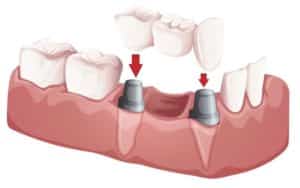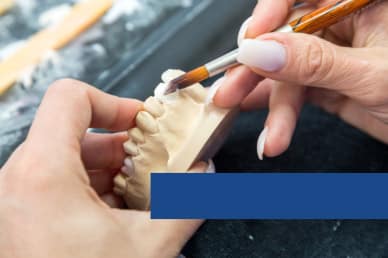
PORCELAIN BRIDGES
A bridge is a device used to fill the space where a tooth has fallen out or been removed. We offer a number of different porcelain bridges at our office in Michigan. A typical bridge consists of a pontic (filler tooth) that is attached to two surrounding crowns (abutments). Once complete, this bridge structure is bonded into the mouth. Without the use of a bridge, gaps in the mouth where natural teeth are missing can cause multiple teeth to shift, lead to occlusion (biting) and / or jaw problems, and spur periodontal disease. Bridges safeguard the integrity of existing teeth and help maintain a healthy, vibrant smile.
THE PROCESS
Bridges usually require two trips to the dentist’s office. During the initial visit, the surrounding teeth are numbed with a local anesthetic. The dentist prepares the surrounding teeth by cleaning any plaque or decay that remains and reducing them so that the crowns can be fitted. The dentist makes a mold of the teeth and sends it off to a dental lab where the customized impression is prepared. The customized mold takes one to two weeks to return to the office. In the interim, patients are fitted with a temporary bridge constructed of acrylic resin. When the patient returns to the dental office, the dentist removes the temporary bridge and replaces it with the permanent one. The dentist then adjusts the bridge for the proper bite and fit, and the porcelain bridge is permanently bonded into the mouth.
TYPES OF BRIDGES
We offer several different types of porcelain bridges to our patients in Michigan. The first is a fixed bridge, which consists of a filler tooth (referred to as a pontic) that is attached to two crowns. The crowns fit over the existing teeth to hold the bridge in place. The fixed bridge is the most popular type of bridge we offer.
Another bridge design is a composite bond, known as a “Maryland” bridge. This type of bridge is commonly used to replace the front teeth. The pontic is attached to metal bands that are bonded to the abutment teeth, and the metal bands are hidden with a white-colored composite resin.
A cantilever bridge is often used when there are teeth on only one side of the span. A typical three-unit cantilever bridge consists of two abutment crowns that are positioned side by side on the same side of the missing tooth space. The pontic is then connected to the two crowns, which extend into the missing tooth space.
If the missing tooth space has no surrounding teeth, the dentist may decide an implant is the most appropriate method of treatment. Please refer to the dental implants section of the Patient Education Library for more information. When a series of teeth are missing, the dentist may suggest a partial denture as the most effective way to maintain the structure of the jawbone and teeth.
PROPER MAINTENANCE
Because the pontic and crowns are constructed as a single piece, special care must be given to ensure that the gum line and area surrounding the new structure are kept clean. Special floss is often necessary to clean underneath the teeth and maintain strong, healthy gums. With proper dental care, bridges can last up to ten years.
Interested in finding out more about porcelain bridges at our office in Michigan? Contact us today!
DaVinci
Dental Studios

We are proud to feature our dental lab, daVinci Dental studios. DaVinci works hand in hand with Dr. Milan to create the best results available in dentistry today.
DaVinci Dental Studios has consistently led the dental industry in innovative and artistic techniques for over 30 years. daVinci started with a commitment to provide the most natural results possible that rivals nature in fit, function and form. The art of creating your smile is accomplished with the finest technicians and materials available which are made in the U.S.A. Each member of daVinci embodies a quality driven love of the creative process and an extreme devotion to the art and science of dentistry.
